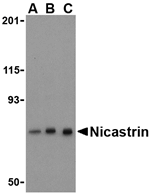Nicastrin, in addition to presenilin, PEN2, and APH-1 forms the gamma-secretase protein complex, a membrane-bound aspartyl protease that can cleave certain proteins at peptide bonds buried within the hydrophobic environment of the lipid bilayer. This cleavage is responsible for a key step in signaling from several cell-surface receptors and is thought to be required for the generation of the neurotoxic amyloid peptides that are central to the pathogenesis of Alzheimer’s disease. Like the tumor necrosis factor-a-converting enzyme (TACE) and the b-site cleavage enzyme (BACE) protease families, gamma-secretase will cleave the amyloid precursor protein (APP), but within the intramembrane region of APP, resulting in either the non-toxic p3 (from the alpha and gamma cleavage site) or the toxic Abeta amyloid peptide (from the beta and gamma cleavage site). It is thought that accumulation of the Abeta peptide is the precursor to Alzheimer’s disease. Nicastrin is also thought to be involved in cell proliferation and signaling, especially in regards to activation of Notch receptors as loss of Nicastrin expression results in mouse embryonic lethality.


